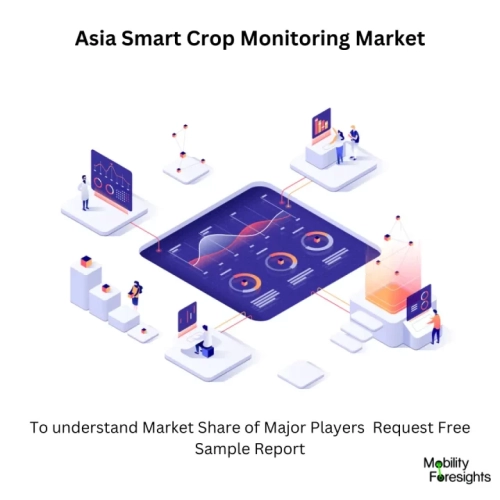
- Get in Touch with Us

Last Updated: Apr 25, 2025 | Study Period:
ASIA SMART CROP MONITORING MARKET
KEY FINDINGS
The Asia Smart Crop Monitoring Market is experiencing robust growth driven by technological advancements and a pressing need for sustainable agricultural practices. With a rapidly growing population and limited arable land, the demand for efficient crop monitoring solutions has become paramount. Technologies such as IoT, AI, and remote sensing are transforming traditional farming practices, allowing farmers to monitor crop health and soil conditions in real-time. These innovations not only enhance productivity but also contribute to resource conservation.
Despite the optimistic outlook, the market faces challenges, including high upfront costs associated with smart crop monitoring technologies. Furthermore, there is a significant skills gap, as many farmers are not equipped to utilize these advanced systems effectively. As the industry evolves, ongoing training and support will be essential to maximize the benefits of smart crop monitoring.
The Asia Smart Crop Monitoring Market encompasses a range of technologies designed to optimize agricultural practices through real-time monitoring and data analysis. This market is significant as it addresses the urgent need for improved agricultural efficiency amid rising food demands and environmental concerns. Key segments within the market include satellite imagery, drone technology, and sensor-based monitoring systems.
Different types of smart crop monitoring solutions cater to various needs, including soil moisture sensors, climate monitoring devices, and pest management systems. These solutions enable farmers to make informed decisions, enhancing crop yields while minimizing resource waste. The diversity in technology offerings reflects the varied agricultural practices across Asia, making this market dynamic and multifaceted.
Applications of smart crop monitoring are extensive, covering fields such as precision agriculture, pest control, and resource management. Farmers leverage these technologies to monitor crop health, predict yields, and optimize irrigation practices. This proactive approach not only improves productivity but also contributes to sustainable farming practices.
While the benefits of smart crop monitoring are clear, challenges remain. High implementation costs and the need for technical expertise can deter small-scale farmers from adopting these solutions. However, as technology becomes more accessible and affordable, the barriers to entry are expected to diminish, paving the way for broader adoption.

Currently valued at approximately USD 1.1 billion, the Asia Smart Crop Monitoring Market is anticipated to expand significantly, reaching USD 2.5 billion by 2030. This represents a CAGR of 12.5% from 2024 to 2030, driven by increasing investment in agricultural technologies and growing awareness of sustainable practices. Key growth drivers include government initiatives aimed at modernizing agriculture and the escalating need for food production efficiency.
Several trends are shaping the future of the Asia Smart Crop Monitoring Market. Firstly, the proliferation of IoT devices is enabling farmers to collect vast amounts of data, which can be analyzed to enhance decision-making. Secondly, the rise of autonomous farming equipment is changing how crop monitoring is conducted, reducing labor costs and increasing operational efficiency. Regulatory frameworks promoting sustainable farming practices are also emerging, encouraging the adoption of smart technologies. Lastly, the increasing popularity of data-driven farming is shifting consumer behavior, with more farmers seeking technology that offers measurable results.
By Technology
By Application
By Crop Type
By Region
| Sr. No | TOPICS |
| 1 | Market Segmentation |
| 2 | Scope of the Report |
| 3 | Research Methodology |
| 4 | Executive Summary |
| 5 | Key Findings |
| 6 | Current Market Size and Dynamics |
| 7 | Market Size, Dynamics, and Forecast, by Technology |
| 8 | Market Size, Dynamics, and Forecast, by Application |
| 9 | Market Size, Dynamics, and Forecast, by Crop Type |
| 10 | Market Size, Dynamics, and Forecast, by Region |
| 11 | Technological Developments in Smart Crop Monitoring |
| 12 | New Product Development in Asia Smart Crop Monitoring Market |
| 13 | Government Regulations and Initiatives |
| 14 | Competitive Landscape |
| 15 | Leading Players |
| 16 | Market Share Analysis |
| 17 | Company Profiles |
| 18 | Unmet Needs and Opportunities |
| 19 | Consumer Insights and Trends |
| 20 | Future Market Projections |
| 21 | Conclusion |